Large Structural Shear Deformation and Failure Monitoring Using Bend Losses in Polymer Optical Fibre
Abstract
:1. Introduction
2. Theoretical Background of POF Sensing with ν-OTDR
2.1. Measurement Principles and Events
2.2. Modal Dispersion, Coupling, and Decoupling Effects on Event Measurement
2.3. Optical and Mechanical Properties of the Optical Fibre
3. Large Deformation Theory
3.1. Bend Loss in Large Shear Deformed Optical Fibre
3.2. OTDR Trace Characteristics of Single Shear Events
3.3. OTDR Trace Characteristics of Double Shear Events
4. Failure Monitoring
4.1. Specimens and Test Procedures
4.2. Test Results and Discussion
5. Conclusions
- When the normalised shear deflections are larger than 0.2, the location and magnitude can be accurately estimated with the proposed technique. Nonetheless, for normalised shear deflections smaller than 0.2, the errors increased, but the event can still be detected and located with an absolute error of less than 0.5 m.
- For closely spaced events with separation distance <0.25 m, the event areas would be overlapped, and only the leading event can be located. Nevertheless, the sum of all individual deflection magnitudes can still be evaluated from the total bend loss.
- For well-separated events with separation distance >5 m, each shear event can be treated and analysed independently.
- For failure monitoring, the OTDR signals increase with the localised bending of the POFs at the beam failure states.
- The POFs attached on the sides of the beams that failed in flexure were purely stretched, and the corresponding OTDR traces had unique features with nearly no bend loss but high reflection intensity.
- Due to the mode dispersion, the signal-to-noise ratio is lower for long-distance measurements, and that reduces the accuracy of detecting small deflection events.
Author Contributions
Funding
Acknowledgments
Conflicts of Interest
References
- CEDIMCEDIM Impact Summary Earthquake Nepal 2015 Report 3. 2015. Available online: https://www.cedim.de/download/CEDIM_ImpactSummary_EarthquakeNepal2015_Report3.pdf (accessed on 17 October 2017).
- Margesson, R.; Taft-Morales, M. Haiti Earthquake: Crisis and Response; Congressional Research Service: Washington, DC, USA, 2010. [Google Scholar]
- Lee, B. Review of the present status of optical fiber sensors. Opt. Fiber Technol. 2003, 9, 57–79. [Google Scholar] [CrossRef]
- Leung, C.K.Y.; Wan, K.T.; Inaudi, D.; Bao, X.; Habel, W.; Zhou, Z.; Ou, J.; Ghandehari, M.; Wu, H.C.; Imai, M. Review: Optical fiber sensors for civil engineering applications. Mater. Struct. 2015, 48, 871–906. [Google Scholar] [CrossRef] [Green Version]
- Habel, W.R.; Bismarck, A. Optimization of the adhesion of fiber-optic strain sensors embedded in cement matrices; a study into long-term fiber strength. J. Struct. Control 2000, 7, 51–76. [Google Scholar] [CrossRef]
- Abbiati, P.; Casciati, F.; Merlo, S. An optical fibre sensor for dynamic structural response monitoring. J. Struct. Control 2000, 7, 35–49. [Google Scholar] [CrossRef]
- Güemes, A.; Soller, B. Optical fiber distributed sensing: Physical principles and applications. Structural Health Monitoring 2009—Form System Integration Autonmous Systems. In Proceedings of the 7th International Workshop Structural Health Monitoring IWSHM 2009, San Diego, CA, USA, 9–11 September 2009; Volume 1, pp. 14–20. [Google Scholar]
- Patsias, S.; Staszewski, W.J. Damage detection using optical measurements and wavelets. Struct. Health Monit. 2002, 1, 5–22. [Google Scholar] [CrossRef]
- Wong, L.; Chiu, W.K.; Kodikara, J. Using distributed optical fibre sensor to enhance structural health monitoring of a pipeline subjected to hydraulic transient excitation. Struct. Health Monit. 2018, 17, 298–312. [Google Scholar] [CrossRef]
- Imai, M.; Feng, M. Sensing optical fiber installation study for crack identification using a stimulated Brillouin-based strain sensor. Struct. Health Monit. 2012, 11, 501–509. [Google Scholar] [CrossRef]
- Min, R.; Ortega, B.; Marques, C. Latest Achievements in Polymer Optical Fiber Gratings: Fabrication and Applications. Photonics 2019, 6, 36. [Google Scholar] [CrossRef] [Green Version]
- Barrias, A.; Casas, J.; Villalba, S. A Review of Distributed Optical Fiber Sensors for Civil Engineering Applications. Sensors 2016, 16, 748. [Google Scholar] [CrossRef] [Green Version]
- Song, Z.-P.; Zhang, D.; Shi, B.; Chen, S.-E.; Shen, M.-F. Integrated distributed fiber optic sensing technology-based structural monitoring of the pound lock. Struct. Control Health Monit. 2017, 24, e1954. [Google Scholar] [CrossRef]
- Liehr, S. Polymer optical fiber sensors in structural health monitoring. In New Developments in Sensing Technology for Structural Health Monitoring; Subhas Chandra Mukhopadhyay; Springer: Berlin, Germany, 2011; pp. 297–333. [Google Scholar]
- Romaniuk, R. Tensile strength of tailored optical fibres. Opto-Electron. Rev. 2000, 8, 101–116. [Google Scholar]
- Peters, K. Polymer optical fiber sensors—A review. Smart Mater. Struct. 2011, 20, 013002. [Google Scholar] [CrossRef]
- Liehr, S.; Lenke, P.; Wendt, M.; Krebber, K.; Seeger, M.; Thiele, E.; Metschies, H.; Gebreselassie, B.; Munich, J.C. Polymer Optical Fiber Sensors for Distributed Strain Measurement and Application in Structural Health Monitoring. IEEE Sens. J. 2009, 9, 1330–1338. [Google Scholar] [CrossRef]
- Large, M.C.J.; Moran, J.; Ye, L. The role of viscoelastic properties in strain testing using microstructured polymer optical fibres (mPOF). Meas. Sci. Technol. 2009, 20, 034014. [Google Scholar] [CrossRef]
- Large, M.C.J.; Poladian, L.; Barton, G.W.; van Eijkelenborg, M.A. Microstructured Polymer Optical Fibres; Springer: New York, NY, USA, 2007. [Google Scholar]
- Fukumoto, T.; Nakamura, K.; Ueha, S. A POF-based distributed strain sensor for detecting deformation of wooden structures. In Proceedings of the 19th International Conference on Optical Fibre Sensors, Perth, Australia, 15–18 April 2008; p. 700469. [Google Scholar]
- Leal-Junior, A.G.; Frizera, A.; Marques, C.; Pontes, M.J. Viscoelastic features based compensation technique for polymer optical fiber curvature sensors. Opt. Laser Technol. 2018, 105, 35–40. [Google Scholar] [CrossRef]
- Husdi, I.R.; Nakamura, K.; Ueha, S. Sensing characteristics of plastic optical fibres measured by optical time-domain reflectometry. Meas. Sci. Technol. 2004, 15, 1553–1559. [Google Scholar] [CrossRef]
- Zhao, J.; Bao, T.; Chen, R. Crack monitoring capability of plastic optical fibers for concrete structures. Opt. Fiber Technol. 2015, 24, 70–76. [Google Scholar] [CrossRef]
- Saatcioglu, M. Structural Damage Caused by Earthquakes. In Encyclopedia of Natural Hazards; Springer: Dordrecht, The Netherlands, 2013. [Google Scholar]
- Viesca, R.C.; Rice, J.R. Modeling Slope Instability as Shear Rupture Propagation in a Saturated Porous Medium. In Submarine Mass Movements and Their Consequences; Mosher, D.C., Shipp, R.C., Moscardelli, L., Chaytor, J.D., Baxter, C.D.P., Lee, H.J., Urgeles, R., Eds.; Springer: Dordrecht, The Netherlands, 2010; pp. 215–225. ISBN 978-90-481-3071-9. [Google Scholar]
- Eraerds, P.; Legre, M.; Zhang, J.; Zbinden, H.; Gisin, N. Photon Counting OTDR: Advantages and Limitations. J. Light. Technol. 2010, 28, 952–964. [Google Scholar] [CrossRef] [Green Version]
- Anderson, D.R.; Johnson, L.M.; Bell, F.G. Troubleshooting Optical Fiber Networks: Understanding and Using Optical Time-Domain Reflectometers; Elsevier Academic Press: Amsterdam, The Netherlands; Boston, MA, USA, 2004. [Google Scholar]
- Huttner, B.; Brendel, J. Photon-counting techniques for fiber measurements. Lightwave 2000, 17, 112–120. [Google Scholar]
- Garito, A.F. Effects of Random Perturbations in Plastic Optical Fibers. Science 1998, 281, 962–967. [Google Scholar] [CrossRef]
- Leal-Junior, A.; Frizera-Neto, A.; Marques, C.; Pontes, M. Measurement of Temperature and Relative Humidity with Polymer Optical Fiber Sensors Based on the Induced Stress-Optic Effect. Sensors 2018, 18, 916. [Google Scholar] [CrossRef] [PubMed] [Green Version]
- Tanio, N.; Nakanishi, T. Physical Aging and Refractive Index of Poly(methyl methacrylate) Glass. Polym. J. 2006, 38, 814–818. [Google Scholar] [CrossRef] [Green Version]
- Liehr, S.; Breithaupt, M.; Krebber, K. Distributed Humidity Sensing in PMMA Optical Fibers at 500 nm and 650 nm Wavelengths. Sensors 2017, 17, 738. [Google Scholar] [CrossRef] [PubMed] [Green Version]
- Broadway, C.; Min, R.; Leal-Junior, A.G.; Marques, C.; Caucheteur, C. Toward Commercial Polymer Fiber Bragg Grating Sensors: Review and Applications. J. Light. Technol. 2019, 37, 2605–2615. [Google Scholar] [CrossRef]
- Luciol Instruments. LOR-200/220 User’s Manual; Luciol Instruments SA: Mies, Switzerland, 2014. [Google Scholar]
- Ziemann, O.; Krauser, J.; Zamzow, P.E.; Daum, W. POF—Polymer Optical Fibers for Data Communication; Springer: Berlin/Heidelberg, Germany, 2002. [Google Scholar]
- Marcuse, D. Curvature loss formula for optical fibers. J. Opt. Soc. Am. 1976, 66, 216. [Google Scholar] [CrossRef]
- Kaufman, K.S.; Terras, R.; Mathis, R.F. Curvature loss in multimode optical fibers. J. Opt. Soc. Am. 1981, 71, 1513. [Google Scholar] [CrossRef]
- Saxena, A.; Kramer, S.N. A Simple and Accurate Method for Determining Large Deflections in Compliant Mechanisms Subjected to End Forces and Moments. J. Mech. Des. 1998, 120, 392. [Google Scholar] [CrossRef]
- Sika. Sikadur-330 Product Data Sheet; Sika: Lyndhurst, NJ, USA, 2018. [Google Scholar]

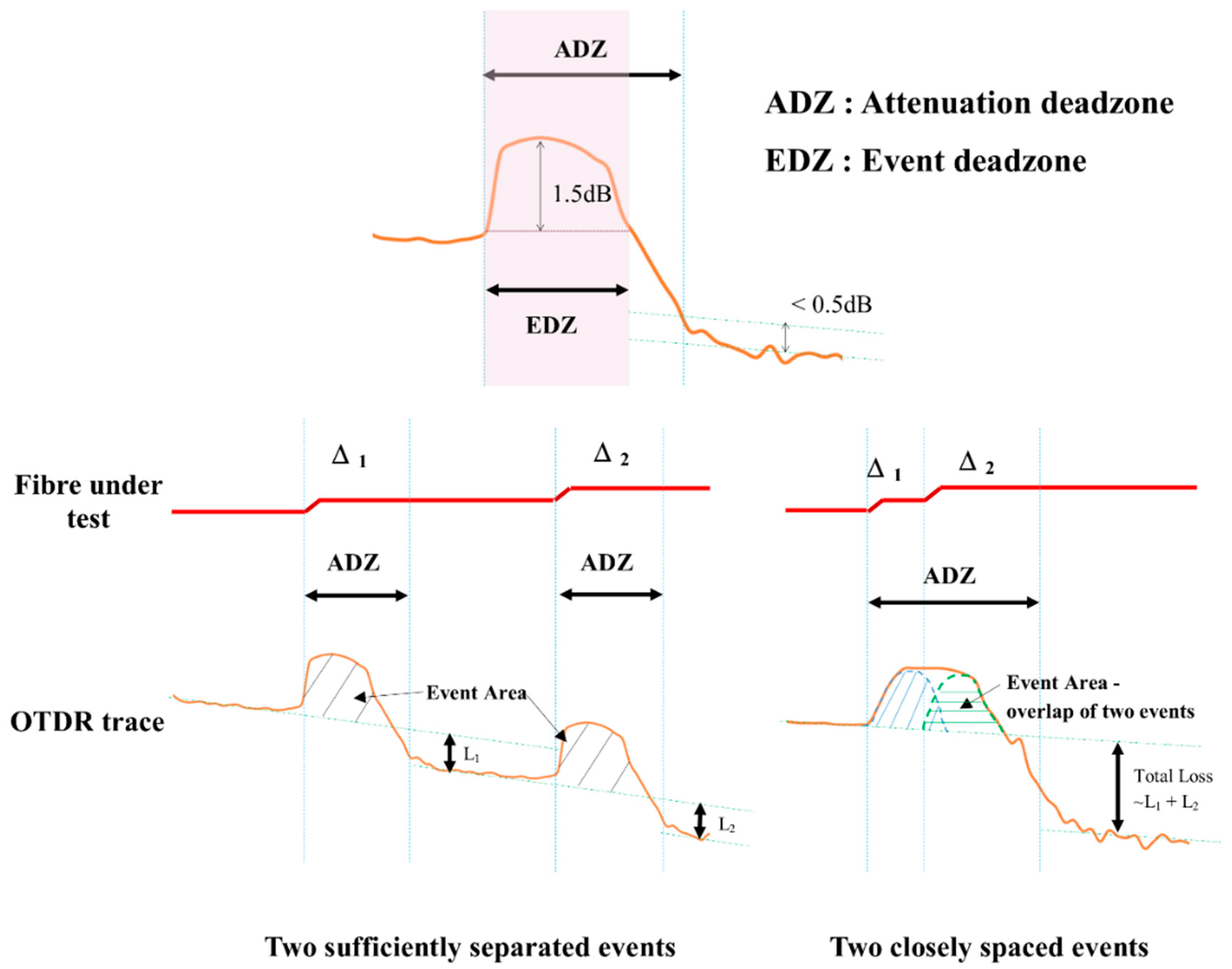
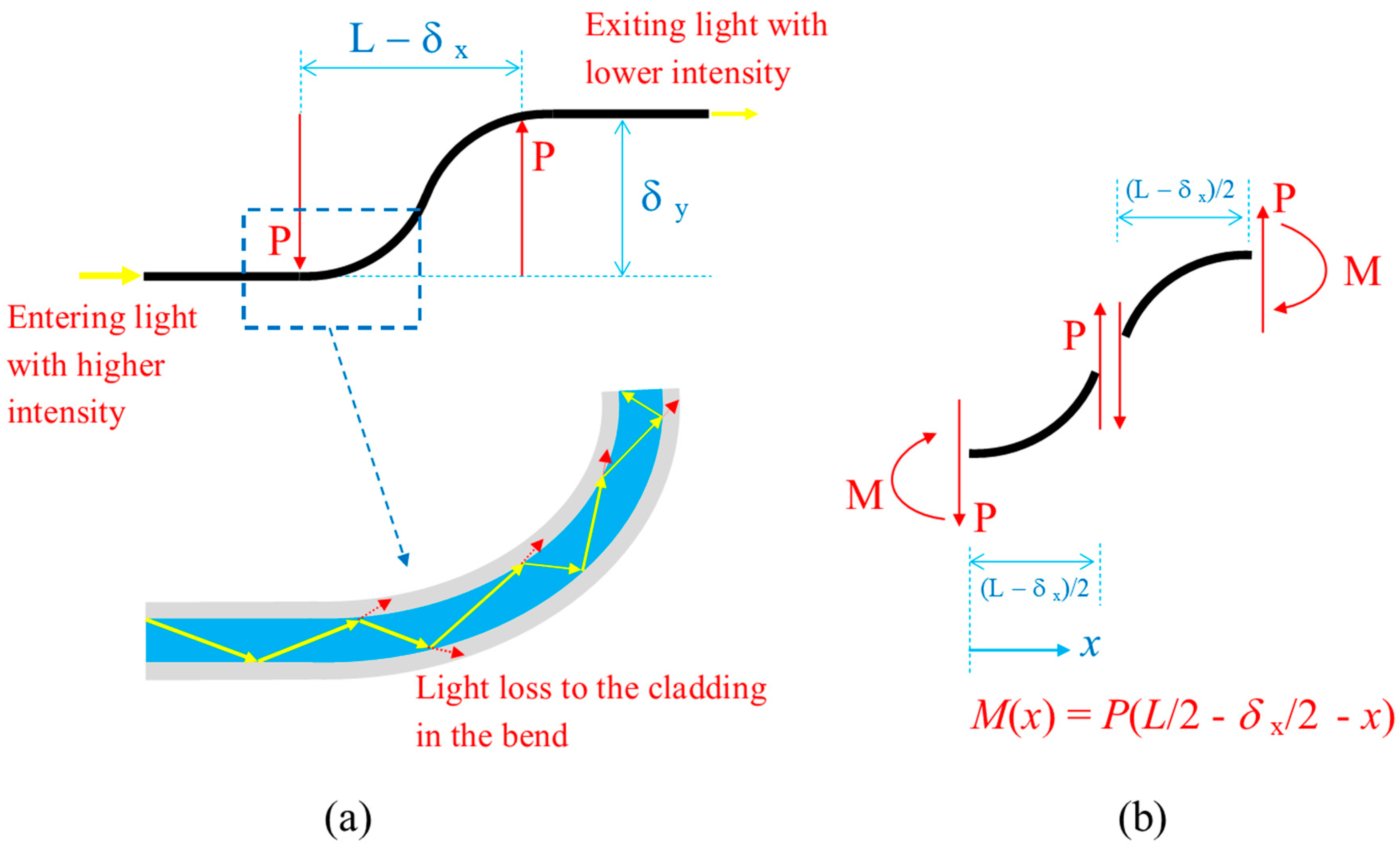

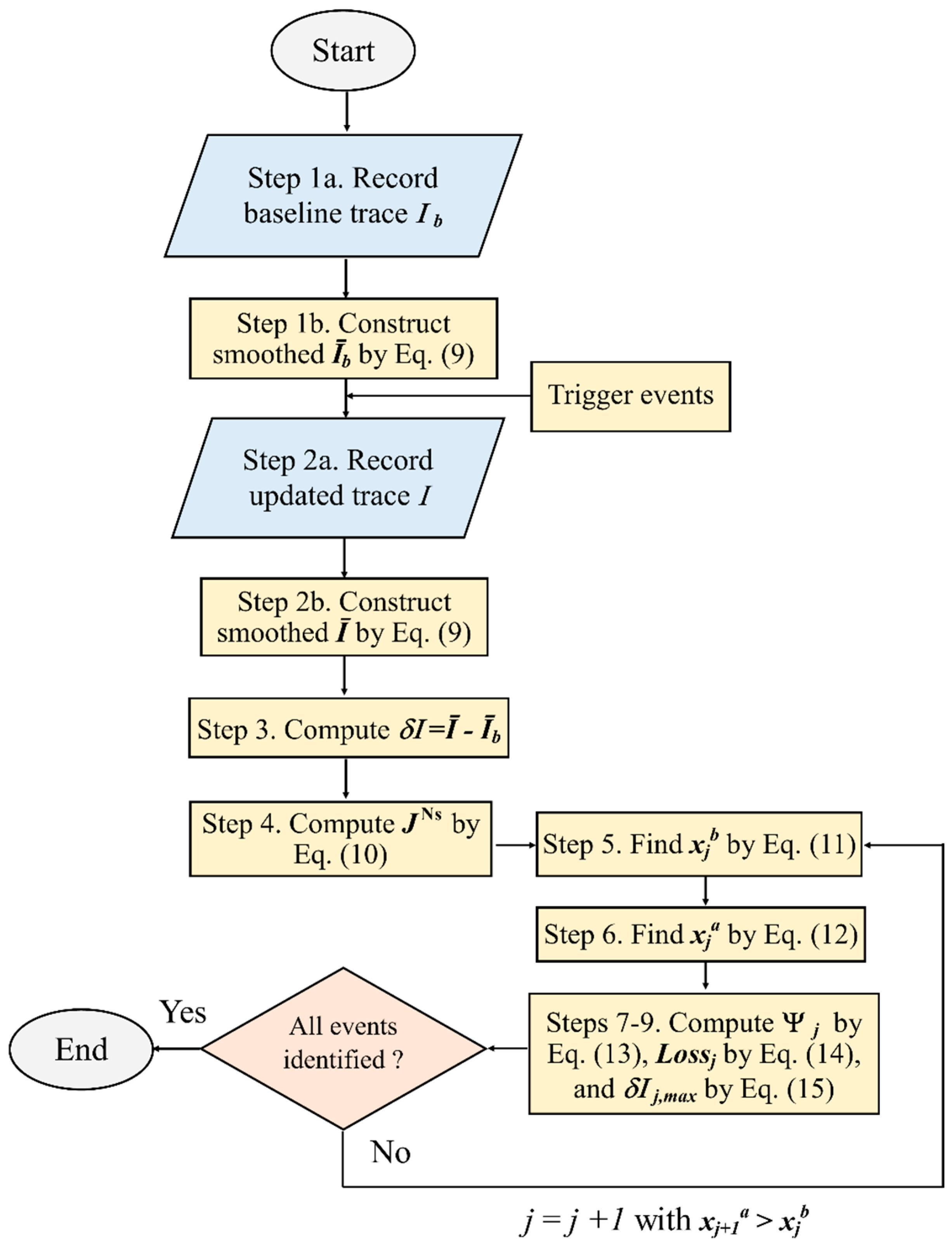

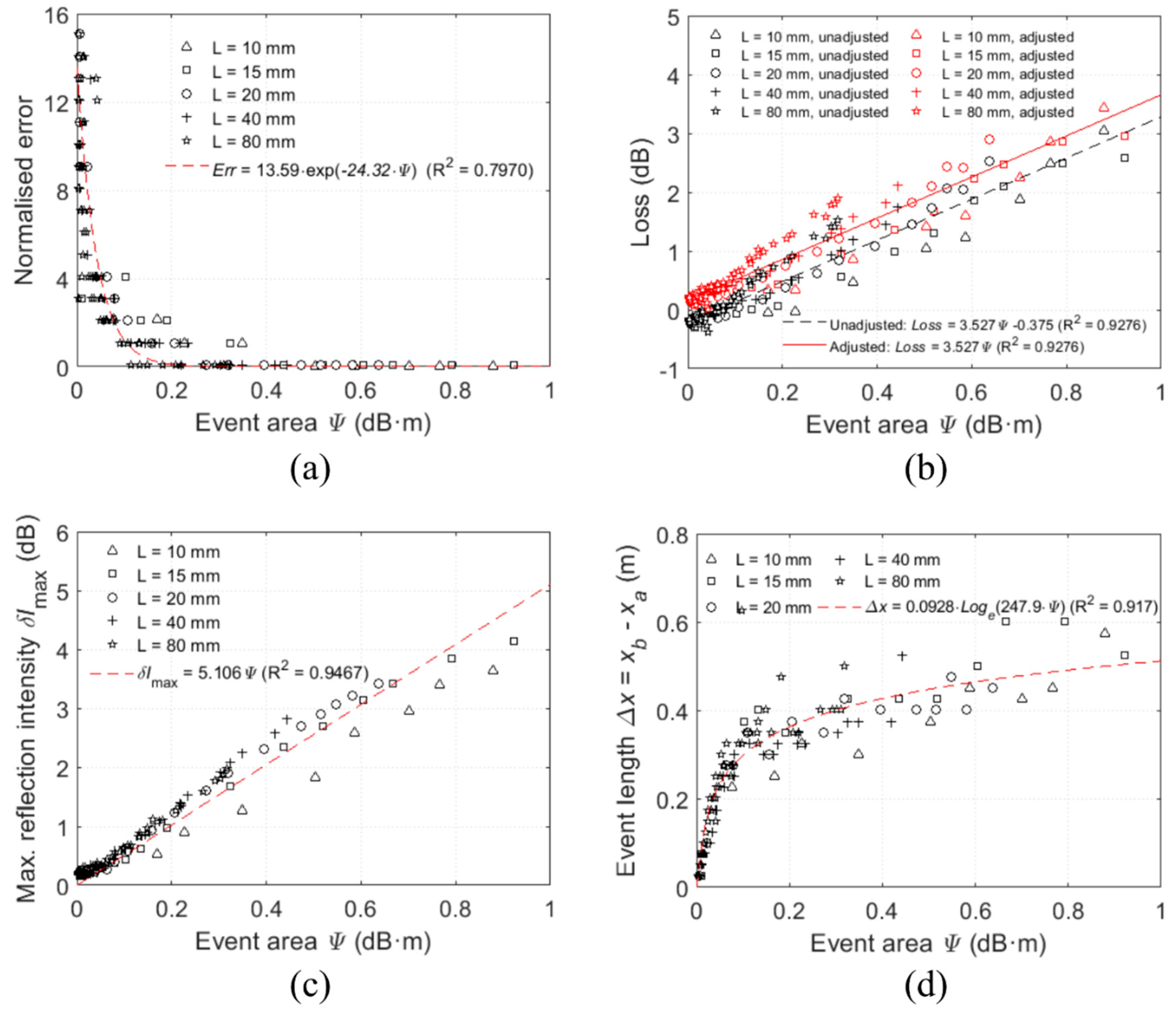
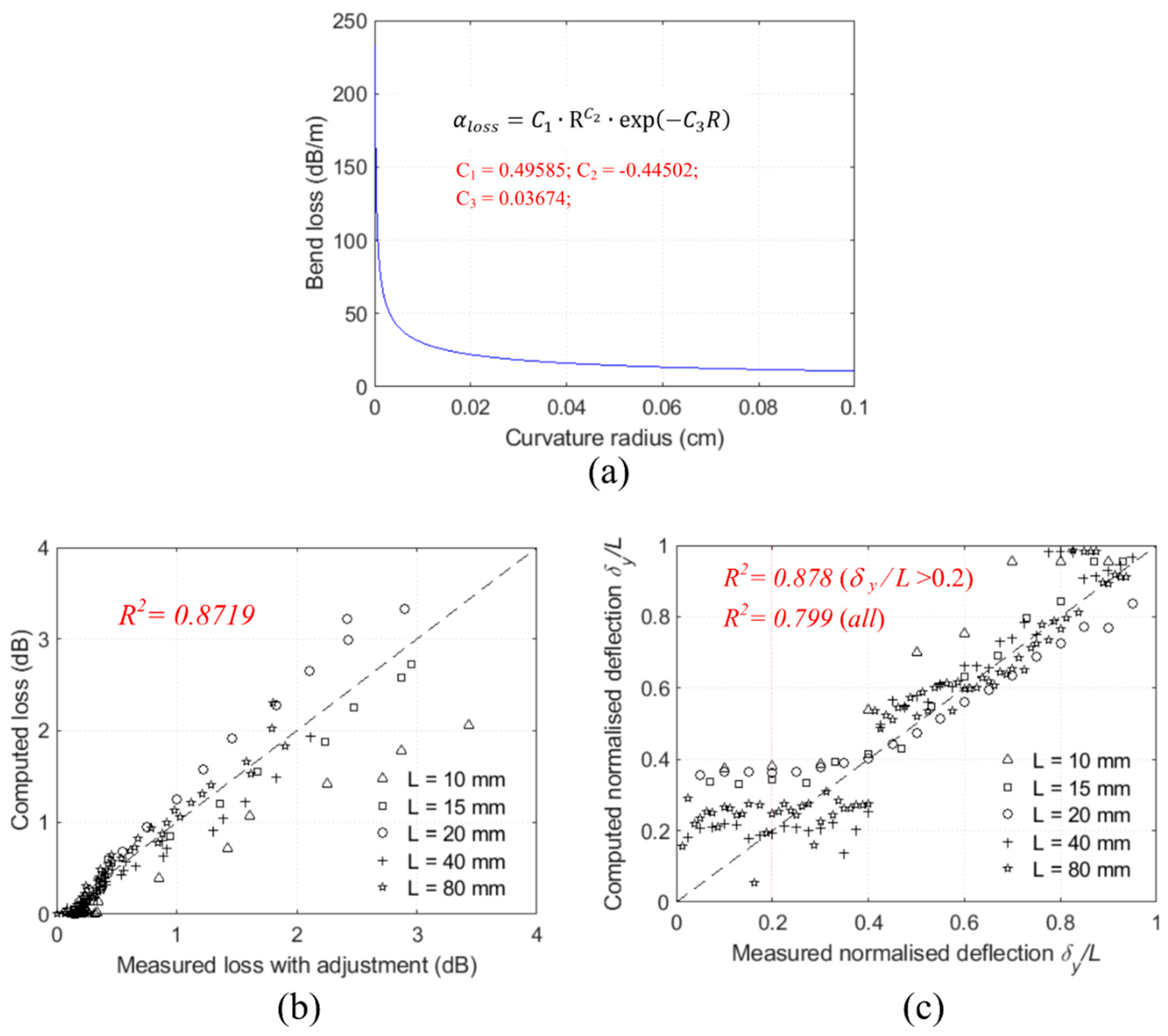
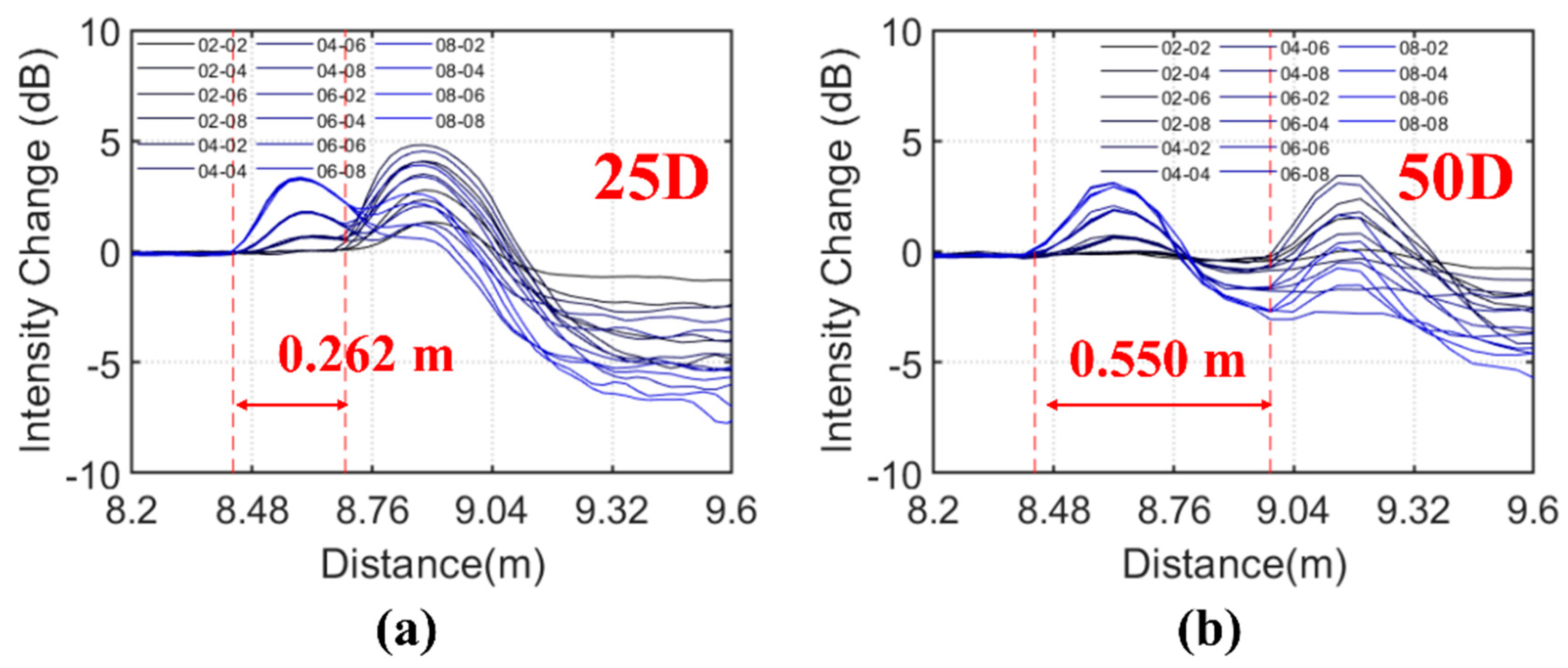
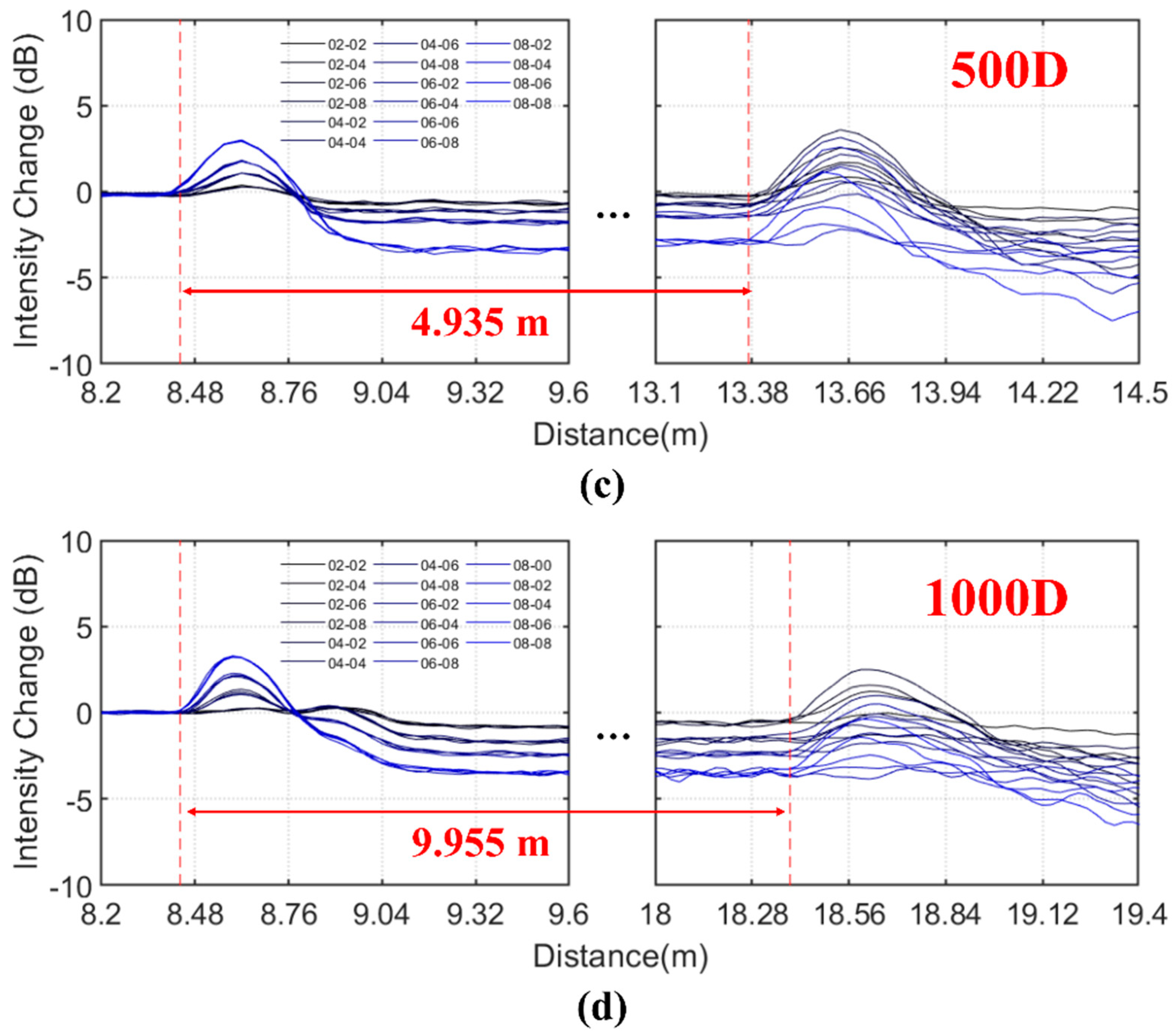
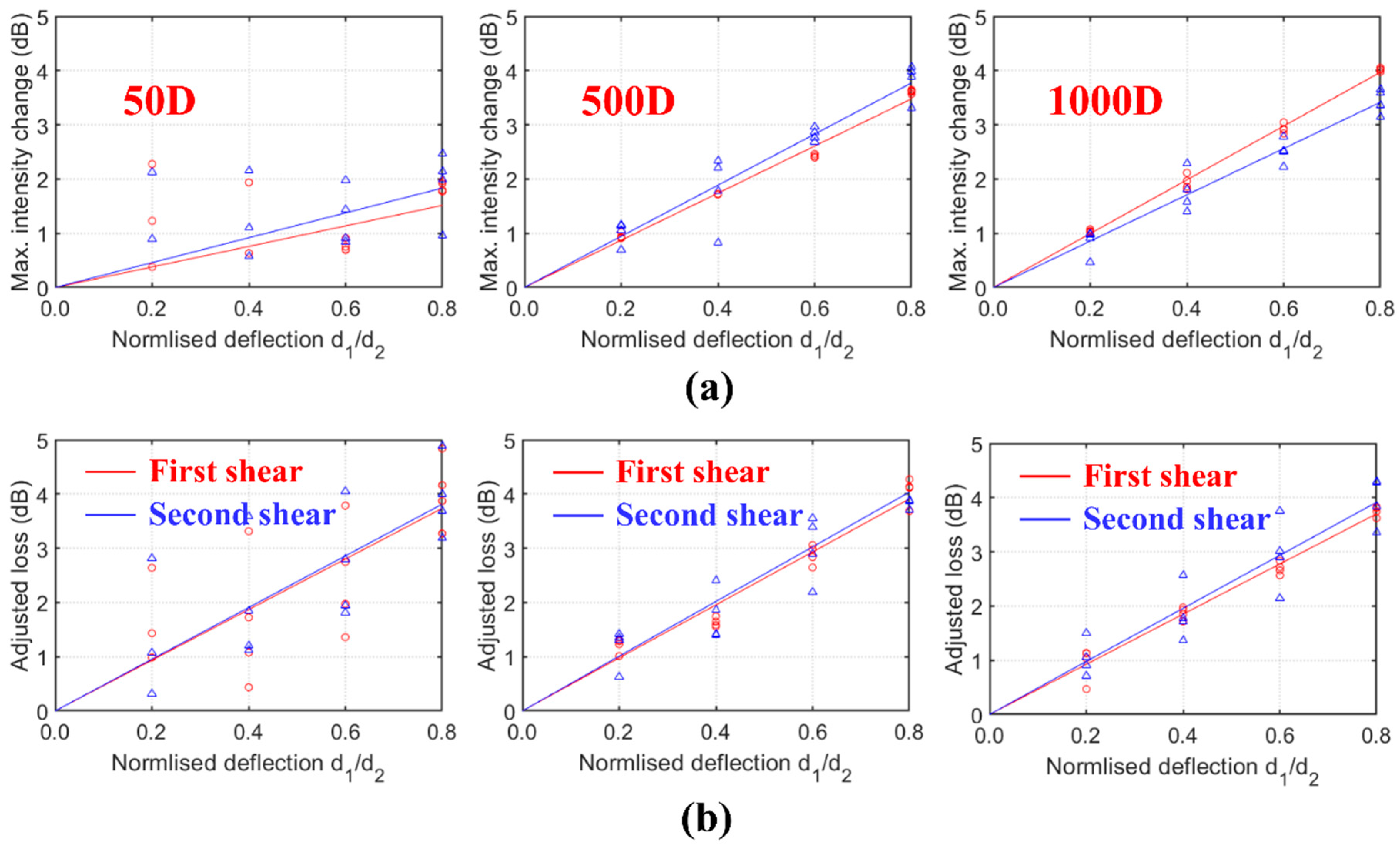



| Specifications | Values/Types |
|---|---|
| Wavelength | 650 nm or 520 nm |
| Optical pulse width | 1 ns |
| Dynamic range | 20 dB |
| Spatial resolution | Any multiple of 2.5 cm |
| Fibre type | Multimode PMMA 1 mm POF |
| Attenuation dead zones | 40 cm (RL * = 45 dB); <1 m (RL = 14 dB) |
| Loss accuracy | ± 0.1 ± 0.02 dB/dB |
| Measurement range | 1.25 km |
| Core | Cladding | Jacket | |
|---|---|---|---|
| Light propagation mode | Multimode with step refractive index profile | ||
| Typical diameter (mm) | 0.98 | 1 | 2.2 |
| Material | Polymethyl–Methacrylate Resin (PMMA) | Fluorinated Polymer | High-Density Polyethylene |
| Typical refractive index | 1.492 | 1.405 | - |
| Typical Young’s modulus (GPa) | 3.09 | 0.68 | 0.8 |
| Maximum operation temperature | 75 °C in a moist atmosphere and 85 °C in a dry atmosphere | ||
| Typical weight (g/m) | 0.88–0.91 | 0.09–0.12 | 3 |
| Yield strength (MPa) | 82 | ||
| Twisting endurance | 5 times for loss increment ≤1 dB | ||
| Repeated bending endurance | 10,000 times for loss increment ≤1 dB | ||
| Numerical aperture | 0.5 | ||
© 2019 by the authors. Licensee MDPI, Basel, Switzerland. This article is an open access article distributed under the terms and conditions of the Creative Commons Attribution (CC BY) license (http://creativecommons.org/licenses/by/4.0/).
Share and Cite
Yuen, T.Y.P.; Tsai, C.-A.; Deb, T.; Lin, Y.-H.; Nyienyi, J.; Wan, K.T.; Huang, Q. Large Structural Shear Deformation and Failure Monitoring Using Bend Losses in Polymer Optical Fibre. Sensors 2020, 20, 195. https://doi.org/10.3390/s20010195
Yuen TYP, Tsai C-A, Deb T, Lin Y-H, Nyienyi J, Wan KT, Huang Q. Large Structural Shear Deformation and Failure Monitoring Using Bend Losses in Polymer Optical Fibre. Sensors. 2020; 20(1):195. https://doi.org/10.3390/s20010195
Chicago/Turabian StyleYuen, Terry Y. P., Cheng-An Tsai, Trissa Deb, Yu-Hsiang Lin, June Nyienyi, Kai Tai Wan, and Qunxian Huang. 2020. "Large Structural Shear Deformation and Failure Monitoring Using Bend Losses in Polymer Optical Fibre" Sensors 20, no. 1: 195. https://doi.org/10.3390/s20010195





